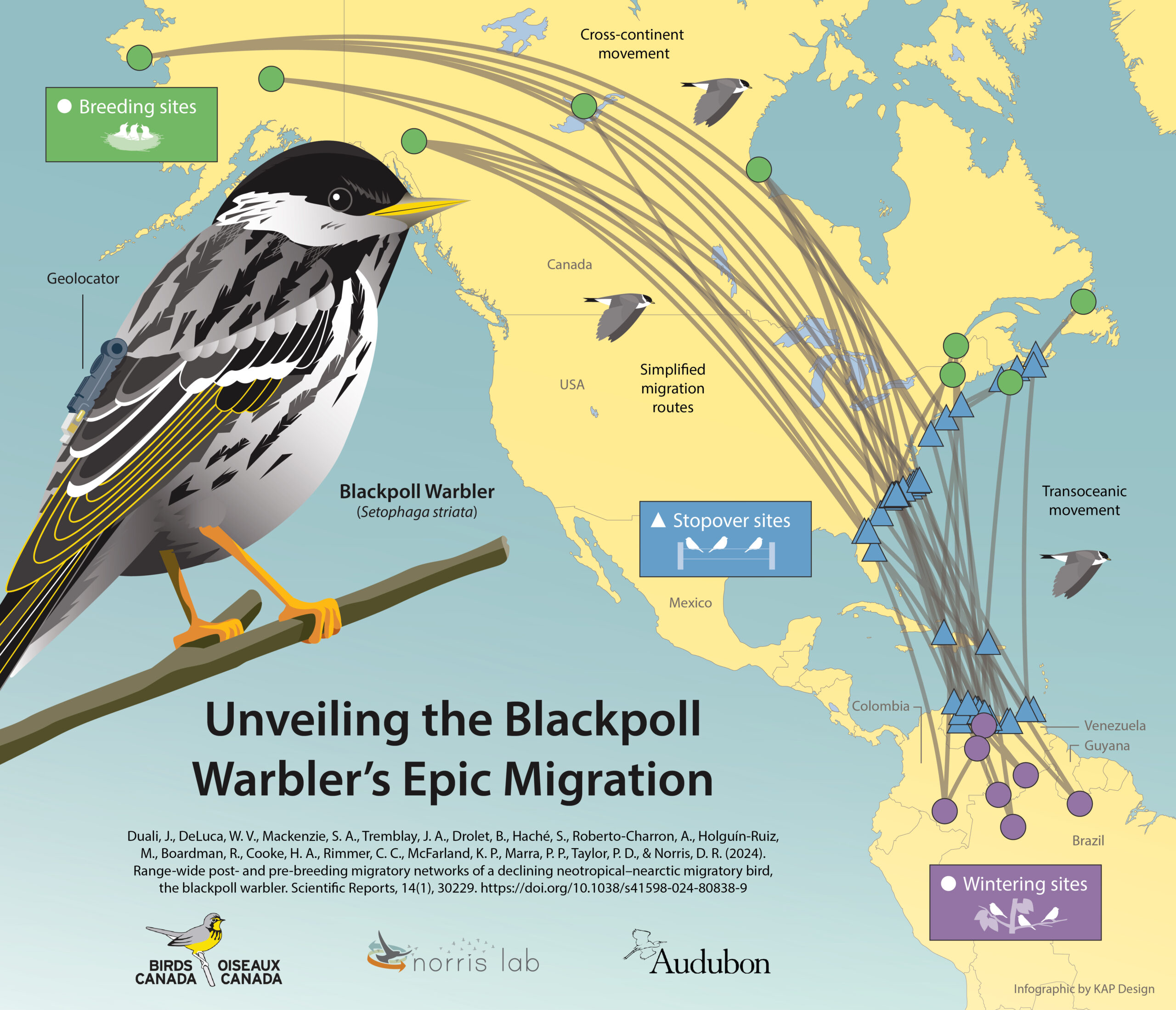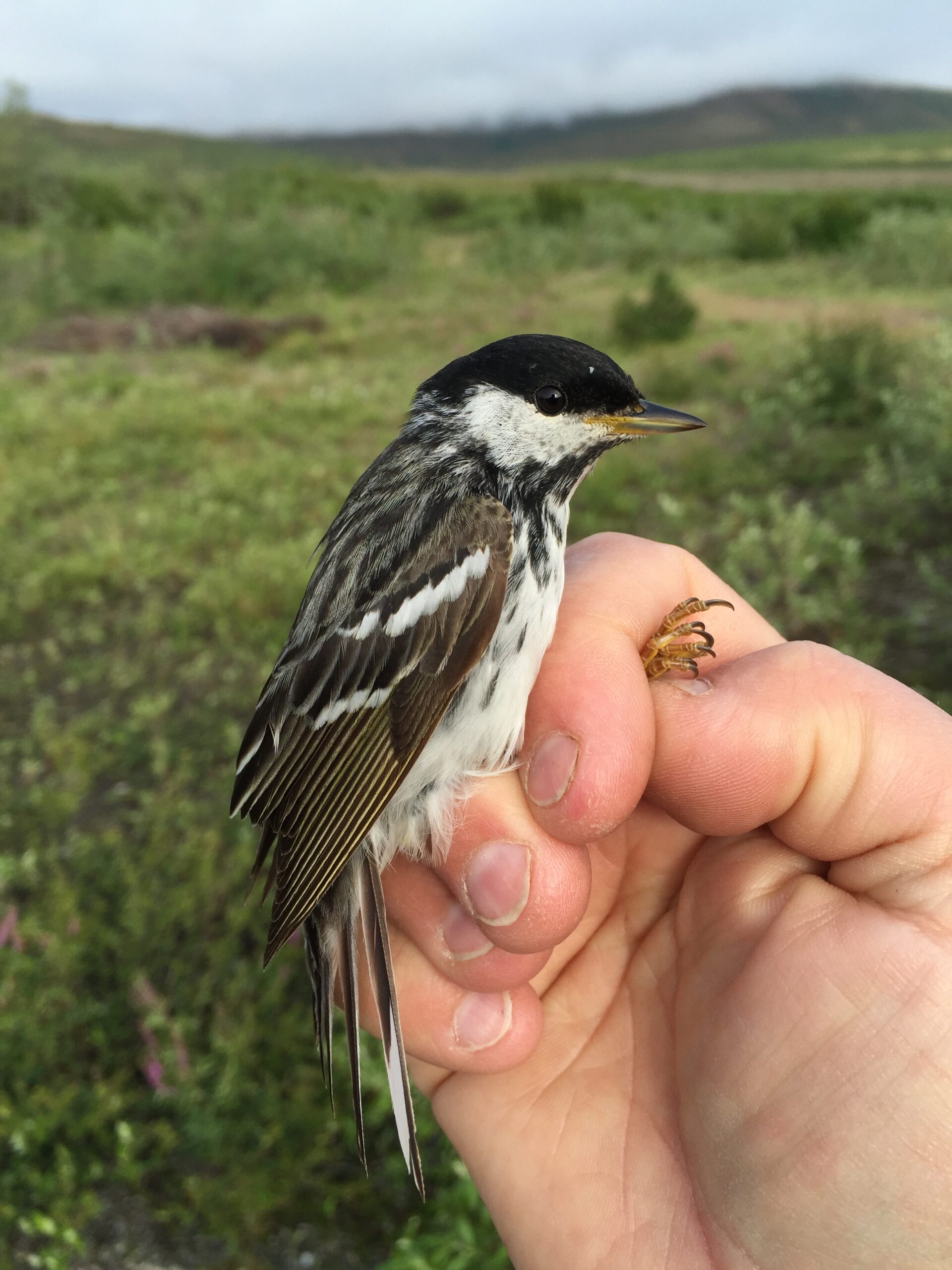By Stuart Mackenzie, Director of Strategic Assets, Birds Canada
The Blackpoll Warbler (Setophaga striata) is a small but extraordinary songbird renowned for its incredible migratory journeys. Weighing just 12 grams, this bird connects boreal forests in North America to tropical regions in South America by traveling thousands of kilometers each year.
For the last decade, a dedicated group of researchers, led by Stu Mackenzie from Birds Canada, Dr. Ryan Norris from the University of Guelph, and Dr. Bill DeLuca from the National Audubon Society, have been studying the complexities of Blackpoll Warbler migration using advanced tracking technologies (primarily light-sensitive geolocators) and Citizen Science data in order to address the pressing need for conservation action. In early December 2024, the group published the culminating results from their work in the journal Nature – Scientific Reports, led by University of Guelph graduate student, and Long Point Bird Observatory (LPBO) cooperator – Jelany Duali.

LPBO cooperator Jelany Duali with Blackpoll Warbler in hand. Photo: Matt Fuirst

Director of Strategic Assets, Stu Mackenzie. Photo: Yousif Attia
Initially our work confirmed that Blackpoll’s fly across the Atlantic Ocean from the eastern seaboard to northern South America as part of their long journey south. We later revealed a “crosswise migration pattern” of the Blackpoll Warbler. Unlike many other migratory birds, individuals from western breeding populations winter in eastern South America, while eastern breeders travel westward.
This crisscrossing highlights the species’ complex migratory networks, which span continents and connects diverse ecosystems. Individuals, weighing no more than 12g, from the farthest western portion of their range travel as far as 12,000 km in a single migration.
These studies have also identified key stopover sites that are essential for the Blackpoll Warbler’s survival. The U.S. eastern seaboard, northern Venezuela, and Colombia emerge as critical hubs where these birds refuel and rest during their arduous journey. These stopover sites enable the warblers to build energy reserves, or recover from non-stop flights over the Atlantic Ocean, possibly exceeding 4,000 kilometers—a feat that places them among the champions of avian endurance.
Despite their remarkable abilities, Blackpoll Warblers are experiencing significant population declines, averaging 2.3% annually since 1970. Habitat loss at key stopover and wintering sites—particularly in South America—poses a grave threat. These disruptions could jeopardize the species’ survival by hindering critical stages of their migratory journey.
Our research underscores the urgency of conserving habitats along the Blackpoll Warbler’s migratory route. Efforts must focus on safeguarding stopover sites, restoring degraded habitats, and addressing threats such as deforestation.
Success will require international collaboration between governments, conservation organizations, and local communities such as the work underway by the Conserva Aves Initiative and LPBO’s Latin American Training Program.

Blackpoll Warbler. Photo: Yousif Attia
How You Can Make a Difference
You can support conservation for migratory species like the Blackpoll Warbler by:
- Participating in Citizen Science projects such as eBird Canada, Christmas Bird Counts, or Project FeederWatch which contribute to our knowledge of the State of Canada’s Birds.
- Contributing to research, habitat restoration, and conservation initiatives across their range, such as Conserva Aves and Science in the North.
- Learn more about how you can be a champion of birds.
The Blackpoll Warbler’s journey is a testament to nature’s resilience and complexity. With concerted efforts, we can ensure this species continues to thrive and inspire future generations.
Additional Reading
For more information check out these resources:
- Motus Wildlife Tracking System Blackpoll Warbler Dashboard
- State of Canada’s Birds Blackpoll Warbler Account
- Bird Migration Explorer – Blackpoll Warbler
- De Luca et al. 2014 -Transoceanic migration by a 12 g songbird
- De Luca et al. 2019 – A boreal songbird’s 20,000 km migration across North America and the Atlantic Ocean
- Bayly et al. 2020 – There’s no place like home: tropical overwintering sites may have a fundamental role in shaping migratory strategies.


